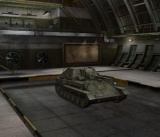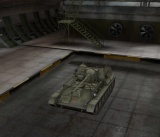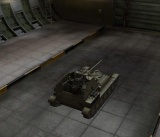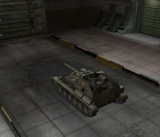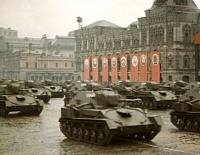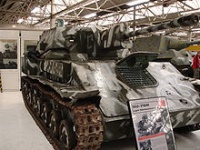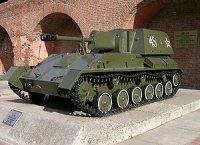SU-76M
| Revision as of 02:26, 2 May 2012 bold, links, etc. | Revision as of 19:55, 5 May 2012 | |||
| Line 5: | Line 5: | |||
| :The SU-76 leads to the [[SU-85B]]. | :The SU-76 leads to the [[SU-85B]]. | |||
| }}{{:{{PAGENAME}}/Modules}}{{:{{PAGENAME}}/Equipment}}{{:{{PAGENAME}}/Consumables}} | }}{{:{{PAGENAME}}/Modules}}{{:{{PAGENAME}}/Equipment}}{{:{{PAGENAME}}/Consumables}} | |||
| + | {{Panel content | |||
| + | |title=Thoughts and Suggestions | |||
| + | |content= | |||
| + | ||||
| + | <h4>Pros and Cons</h4> | |||
| + | ||||
| + | Pros: | |||
| + | ||||
| + | * Above average top speed and traverse speed | |||
| + | * Above average penetration and rate of fire | |||
| + | * Above average accuracy | |||
| + | * Above average elevation arc | |||
| + | * Above average ammo capacity | |||
| + | * Above average signal range | |||
| + | ||||
| + | ||||
| + | Cons: | |||
| + | ||||
| + | * Below average hit points | |||
| + | * Below average engine power | |||
| + | * Below average armour | |||
| + | * Below average damage | |||
| + | * Below average gun arc | |||
| + | * Below average view range | |||
| + | ||||
| + | ||||
| + | <h4>Combat Effectiveness</h4> | |||
| + | ||||
| + | ||||
| + | ||||
| + | ||||
| + | <h4>Early Research</h4> | |||
| + | ||||
| + | * | |||
| + | ||||
| + | ||||
| + | {{EquipmentPanel|Medium-Caliber Tank Gun Rammer, Enhanced Gun Laying Drive, Cyclone Filter, "Wet" Ammo Rack Class 1, Enhanced Torsion Bars 1 t Class|Suggested Equipment}} | |||
| + | }} | |||
| {{Panel Gallery|Gallery| | {{Panel Gallery|Gallery| | |||
| [[File:SU76-a.jpg|160px|Front right]] | [[File:SU76-a.jpg|160px|Front right]] | |||
Revision as of 19:55, 5 May 2012
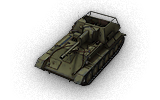
The SU-76 is a Soviet tier 3 tank destroyer. It is light weight, fast, and has better armor than any other tier 3 Soviet tank. It also has has better gun options than other tier 3 Soviet tanks. The SU-76 should be given respect on the battlefield as the tank killer it truly is.
- The SU-76 leads to the SU-85B.
R24 SU-76/ModulesR24 SU-76/EquipmentR24 SU-76/Consumables
Pros and Cons
Pros:
- Above average top speed and traverse speed
- Above average penetration and rate of fire
- Above average accuracy
- Above average elevation arc
- Above average ammo capacity
- Above average signal range
Cons:
- Below average hit points
- Below average engine power
- Below average armour
- Below average damage
- Below average gun arc
- Below average view range
Combat Effectiveness
Early Research
Suggested Equipment
Historical Info
The SU-76 was based on a lengthened and widened version of the T-70 tank chassis. Its simple construction made it the second-most produced Soviet armored vehicle of World War II, after the T-34 tank.
Crews loved this vehicle for its simplicity, reliability, and ease of use, although it was sometimes nicknamed 'suka' (bitch), 'Suchka' (little bitch) or 'Golozhopiy Ferdinand' (bare-arsed Ferdinand) for its layout which recalled the massive Porsche-designed German tank hunter, and its open rear. One famous crewman was Rem Nikolaevich Ulanov, who is a distinguished German-Soviet War veteran. In his younger days, he was a mechanic-driver and later a commander of an SU-76. He and some other soldiers called their SU-76 Columbina after the female Renaissance Italian Commedia dell'Arte personage.
Design of the SU-76 began in November 1942, when the State Defense Committee ordered the construction of infantry support self-propelled guns armed with the ZiS-3 76.2 mm gun and the M-30 122 mm howitzer. The T-70 chassis was chosen for mounting the ZiS-3 gun and was lengthened, adding one road wheel per side to facilitate better gun mounting.
In the rush for fast completion of the order, a quite unreliable power plant was installed in the first mass produced SU-76s. It utilized two automobile engines (GAZ-202) mounted in "parallel", each track with its own engine. It was found to be difficult for the driver to control the two engines simultaneously. Moreover, strong vibrations led to early failures of engines and transmission units. The vehicle was completely enclosed by armor. After producing 320 SU-76s, mass production was halted in order to fix the problems. Two chief designers at the GAZ plant, N. A. Astrov and A. A. Lipgart, changed the power plant to the reliable T-70 design. The roof of the compartment was removed for better gun servicing. This modified version, called the SU-76M, began mass production in early 1943. The production halt and redesign was the reason for the introduction of the SU-76i (see later) as a temporary replacement for the SU-76.
After the pause, GAZ and two factories in Kirov and Mytishchi produced 13,932 SU-76Ms (the larger part of the order, over 9,000 vehicles, were built solely by GAZ). Mass production of the SU-76M ceased in the second half of 1945. In contemporary accounts, SU-76Ms are often referred to in texts, public radio, and TV broadcasting as SU-76s with the "M" omitted, due to their ubiquity in comparison with the original SU-76s. The SU-76 was the basis for the first Soviet tracked armored anti-aircraft vehicle, the ZSU-37. Mass production of the ZSU-37 was continued after SU-76M production ceased. The SU-76M was withdrawn from Soviet Army service after the Second World War ended.
Variants
- OSU-76 -- Experimental model based on the T-60 tank chassis.
- SU-76 -- Based on a lengthened T-70 tank chassis, with the inferior dual-engine arrangement of earlier T-70s. Only a few were produced, and these were quickly withdrawn from front line service.
- SU-76M -- Main production model.
- SU-76B -- Featured a completely enclosed armoured crew compartment. Only a few were produced.
- ZSU-37 -- Self-propelled anti-aircraft gun, based on the SU-76.
The unrelated SU-76i (1943) was based on the German Panzer III and StuG III chassis, armed with a ZiS-5 76.2 mm gun. About 1,200 of these captured vehicles, many from Stalingrad, were converted at Factory No. 38 by adding a new enclosed superstructure. They were issued to tank and self-propelled gun units starting in autumn 1943.[1]
Combat history
The SU-76M virtually replaced infantry tanks in the close support role. Its thin armor and open top made it vulnerable to antitank weapons, grenades, and small arms. Its low weight and low ground pressure gave it good mobility.
The SU-76M combined three main battlefield roles: light assault gun, mobile anti-tank weapon, and mobile gun for indirect fire. As a light assault gun, the SU-76M had good estimation from Soviet infantrymen (in contrast with their own crews). It had more powerful weapons than any previous light tank for close support and communication between infantry and the SU-76M crew was simple, due to the open crew compartment. This was extremely useful in urban combat where good teamwork between infantry and AFVs is a key to success. Although the open compartment was highly vulnerable to small arms fire and hand grenades, it very often saved the crew's lives in the case of a hit by a Panzerfaust, whose concussion blast would mean death in an enclosed vehicle.
The SU-76M was effective against any medium or light German tank. It could also knock out the Panther tank with a flank shot, but the ZiS-3 gun was not sufficient against Tiger tanks. Soviet manuals for SU-76M crews usually instructed the gunner to aim for the tracks or gun barrel against Tigers. To improve the SU-76M's anti-armor capabilities, armor-piercing composite rigid (APCR) and hollow charge projectiles were introduced. This gave the SU-76M a better chance against heavily armored German vehicles. A low profile, a low noise signature, and good mobility were other advantages of the SU-76M. This was ideal for organizing ambushes and sudden flank or rear strikes in close combat, where the ZiS-3 gun was sufficient against most German armored fighting vehicles.
The maximum elevation angle of the ZiS-3 was the greatest amongst all other Soviet self-propelled guns. The maximum indirect fire distance was nearly 17 km. SU-76Ms were sometimes used as light artillery vehicles (like the German Wespe) for bombardments and indirect fire support. However, the power of the 76.2 mm shells was not sufficient in many cases.
The SU-76M was the single Soviet vehicle able to operate in swamps with minimal support from engineers. During the Belarus liberation campaign in 1944, it was extremely useful for organizing sneak attacks through swamps: bypassing heavy German defenses on firmer ground. Usually, only lightly-armed infantry could pass through large swampy areas. With SU-76M support, Soviet soldiers and engineers could effectively destroy enemy strong-points and continue to advance. The SU-76M had a large number of ammunition types. They included armor-piercing (usual, with ballistic nose and subcaliber hyper-velocity), hollow charge, high explosive, fragmentation, shrapnel, and incendiary projectiles. This made the SU-76M a true multi-purpose light armored fighting vehicle. After World War II, the SU-76 was used by Communist forces in the Korean War.
Surviving examples
Due to the large number of vehicles produced, many SU-76Ms have survived the post-war years, and most of the larger Russian military museums have examples of the SU-76M in their exhibitions. They can also be found at the German-Soviet War monuments or memorials in different Russian, Belarusian, Ukrainian, and Polish cities. There is a nice example at the Muzeul Militar National in Bucharest, Romania.
- Zaloga 1984, p 180.
References
- Zaloga, Steven J., James Grandsen (1984). Soviet Tanks and Combat Vehicles of World War Two, London: Arms and Armour Press. ISBN 0-85368-606-8.
- Dougherty, Martin J. (2008). Tanks; From World War I to the Present Day, New York: Metro Books. ISBN 1-4351-0123-4
External links
- [Axis History Factbook]
- [SU-76] series and [SU-76i] at Battlefield.ru]]
- [LemaireSoft]
- [OnWar]
- [WWII Vehicles]
- [Interview with SU-76 gunner]
| Light Tanks | MS-1 • BT-2 • Tetrarch • T-26 • T-60 • BT-7 • BT-SV • LTP • M3 Light • T-127 • T-46 • T-70 • A-20 • T-50 • T-80 • Valentine II • T-50-2 • MT-25 |
| Medium Tanks | A-32 • T-28 • Matilda IV • T-34 • T-34-85 • A-43 • KV-13 • T-43 • A-44 • T-44 • Object 416 • T-54 • Object 430 II • Object 283 • T-62A • Object 140 • Object 430 |
| Heavy Tanks | Churchill III • KV • KV-1 • KV-220 • KV-220 Beta-Test • KV-1S • KV-2 • T-150 • IS • KV-3 • IS-3 • IS-6 • KV-4 • KV-5 • IS-8 • ST-I • IS-4 • IS-7 |
| Tank Destroyers | AT-1 • SU-76 • SU-85B • SU-85 • SU-85I • SU-100 • SU-100Y • SU-100M1 • SU-122-44 • SU-152 • ISU-152 • SU-101 • Object 704 • SU-122-54 • Object 263 • Object 268 |
| Self-Propelled Guns | SU-18 • SU-26 • SU-5 • SU-122A • SU-8 • S-51 • SU-14-1 • SU-14-2 • 212A • Object 261
|
